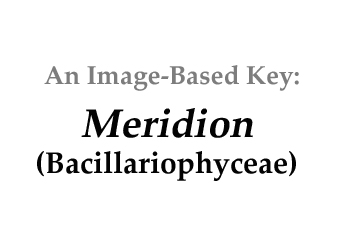|
|
|
|
||
|
|
||||
|
|
|
|||
|
Click on images for larger format |
||||
Name derivation: |
||||
|
Greek Meridion meaning southern. |
||||
Classification: |
||||
Maridion Agardh 1824; 6 of 19 species descriptions are currently accepted taxonomically.Order: Fragilariales, Family: Fragilariaceae |
||||
Morphology: |
||||
|
Cells are attached closely by their valve faces to form a fan shaped colony. the cells are heteropolar or larger at one end than the other in both girdle and valve view. Prominant ribboning is visible in both views with prominent, irregular, discoid plastids that ly along the valve face. One of the few genera that can form resting spores. |
||||
Similar genera: |
||||
|
In valve vew can be similiar to Diatoma that is not heteropolar and has thickened striations that are evenly placed across the cell. The thickened striations at each pole curve downward and there is a thickened central raphe. Can also be confused with Gonphonema in girdle view but in not attached to muscilage stalks as Gonphonema is. |
||||
Habitat: |
||||
|
Meridion is a strictly freshwater species that is found attached to stones and plants almost always in flowing water. Often abundant in freshwater springs. |
||||
References: |
||||
|
Agardh, C.A. 1824. Systema Algarum. pp. [i]-xxxvii, [1]-312. Lundae [Lund]: Literis Berlingianis [Berling]. Guiry, M.D. and G.M. Guiry 2014. AlgaeBase. World-wide electronic publication, National University of Ireland, Galway. http://www.algaebase.org; searched on 19 December 2012. Round, F. E., Crawford, R. M., Mann, D. G. 1990. The Diatoms. Cambridge University Press. New York, NY. |
||||



